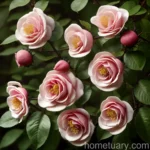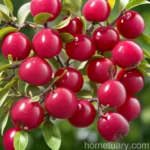Lady’s Mantle (Alchemilla mollis ‘Thriller’): A Comprehensive Guide
Lady’s mantle (Alchemilla mollis ‘Thriller’) is a beautiful and versatile perennial plant that is prized for its delicate, frothy flowers and attractive foliage. In this comprehensive guide, we will explore the key aspects of this plant, including its culture, uses, care requirements, propagation, common diseases and pests, as well as some fun facts and botanist’s tips. Whether you’re a seasoned gardener or a plant enthusiast looking to add a new species to your collection, this guide will provide you with all the essential information you need to grow and care for lady’s mantle effectively.
What is Lady’s Mantle (Alchemilla mollis ‘Thriller’)?
Lady’s mantle, scientifically known as Alchemilla mollis ‘Thriller’, is a herbaceous perennial plant that belongs to the Rosaceae family. It is native to southern Europe and thrives in temperate climates. The plant is characterized by its rounded, slightly scalloped, and deeply veined leaves, which resemble the shape of a lady’s cloak, giving rise to its common name. Lady’s mantle is well-loved for its elegant, airy blooms, which appear in early summer and last well into the autumn.
Key Takeaways – Lady’s Mantle (Alchemilla mollis ‘Thriller’)
Before diving into the specific details of lady’s mantle, let’s take a look at some key takeaways that cover the essential aspects of this plant.
- Scientific Name: Alchemilla mollis ‘Thriller’
- Common Name: Lady’s Mantle
- Plant Type: Herbaceous perennial
- Foliage: Semi-evergreen
- Flowering Season: Late spring to early summer
- Sunlight: Partial shade to full sun
- Soil Type: Moist, well-draining soil
- USDA Hardiness Zones: 3-8
- Watering: Moderate
- Uses: Borders, ground cover, cut arrangements
- Height: 12-18 inches
- Spread: 18-24 inches
Now, let’s delve into each aspect of lady’s mantle in detail, from its cultural requirements to its propagation and care techniques.
Culture
Lady’s mantle is a relatively low-maintenance plant with a charming appearance that makes it a popular choice for gardeners and landscapers. Understanding the culture and growth habits of lady’s mantle is essential for successfully cultivating and caring for this beautiful perennial.
Uses
Lady’s mantle (Alchemilla mollis ‘Thriller’) holds numerous uses in the garden and landscaping. Understanding these uses can help you make the most of this versatile plant in your outdoor spaces.
- Borders: Lady’s mantle is a fantastic addition to borders and edging, where its lush foliage and delicate flowers create a soft and welcoming appearance.
- Ground Cover: Due to its spreading nature, lady’s mantle can be used as a ground cover to fill in gaps and create a cohesive look in the landscape.
- Cut Arrangements: The airy, chartreuse flower clusters of lady’s mantle make stunning additions to fresh flower arrangements, adding texture and a touch of whimsy to bouquets and floral displays.
Water
Proper watering is crucial for the health and vigor of lady’s mantle plants. Understanding the plant’s water requirements will help you maintain optimal soil moisture levels to support healthy growth.
- Watering Frequency: Lady’s mantle plants benefit from moderate and consistent watering throughout the growing season. While they prefer moist soil, they should not be waterlogged, as this can lead to root rot.
- Established Plants: Once established, lady’s mantle typically demonstrates good drought tolerance, but regular watering during dry spells is still recommended to promote robust flowering and foliage growth.
- Mulching: Applying a layer of organic mulch around the base of lady’s mantle plants can help retain soil moisture and regulate temperature, enhancing their overall performance.
Sunlight
Lady’s mantle performs best in partial shade to full sun conditions, but it also exhibits some tolerance for shade. Understanding its sunlight requirements is essential for proper placement in the garden or landscape.
- Partial Shade: In warmer regions, providing lady’s mantle with partial shade during the hottest part of the day can help prevent leaf scorch and maintain vibrant foliage color.
- Full Sun: While lady’s mantle can thrive in full sun, it may benefit from some protection from intense afternoon sun in hotter climates. However, in cooler regions, full sun exposure can promote robust flowering and lush growth.
Fertilizer
Fertilizing lady’s mantle can help support healthy growth and abundant flowering. Here are some key points to consider when fertilizing this perennial plant.
- Balanced Fertilizer: Apply a balanced, all-purpose fertilizer in the spring as new growth emerges to provide the plant with essential nutrients for the growing season.
- Organic Amendments: Incorporating organic matter such as compost or well-aged manure into the soil around lady’s mantle plants can improve soil structure and fertility, promoting overall plant health.
Soil
Lady’s mantle thrives in moist, well-draining soil with a slightly acidic to neutral pH. Understanding its soil preferences is crucial for providing an ideal growing environment for this plant.
- Moisture Retention: The ability of the soil to retain moisture is important for lady’s mantle, as it prefers consistently moist conditions without becoming waterlogged.
- Well-Draining Soil: Good drainage is essential to prevent waterlogged conditions, which can lead to root rot and other moisture-related issues in lady’s mantle plants.
- Soil pH: Lady’s mantle performs best in soil with a pH range of 4.5 to 6.5, although it can tolerate slightly alkaline conditions if the soil is rich and well-draining.
Pruning
Proper pruning helps maintain the attractive appearance of lady’s mantle and promotes vigorous growth and flowering. Understanding the pruning guidelines for this plant is essential for successful cultivation.
- Deadheading: Removing spent flowers regularly can prolong the blooming period of lady’s mantle and encourage the development of new flower buds.
- Cutting Back: After the initial flowering period, cutting back the spent flower stalks and any straggly or damaged foliage can rejuvenate the plant’s appearance and encourage a flush of new growth and flowers.
Propagation
Lady’s mantle can be propagated through several methods, including division, seed sowing, and transplanting. Learning about the various propagation techniques can help you expand your lady’s mantle collection and share the beauty of this plant with others.
Division
Dividing established lady’s mantle clumps is a simple and effective way to propagate the plant and create new specimens for your garden or landscape.
- Timing: The best time to divide lady’s mantle is in the early spring before new growth emerges or in the early autumn when the weather begins to cool.
- Procedure: Using a sharp garden spade, carefully dig up a mature lady’s mantle clump, making sure to include a portion of the roots. Gently separate the clump into smaller sections, each with its own set of roots and foliage, and replant them in suitable locations.
Seed Sowing
Growing lady’s mantle from seeds allows you to explore the fascinating process of plant propagation and produce new plants with unique characteristics.
- Sowing Time: Lady’s mantle seeds can be sown in the early spring or early autumn, depending on your local climate and growing conditions.
- Germination: Start the seeds indoors in trays or pots filled with a well-draining seed-starting mix. Keep the soil consistently moist and provide a warm, bright location for germination to occur.
- Transplanting: Once the seedlings have developed several sets of true leaves, they can be transplanted into individual pots or directly into the garden, spacing them according to their mature size.
Container Popularity
While lady’s mantle is commonly grown in garden borders and landscapes, it also thrives in containers, making it a versatile option for aspiring and experienced container gardeners.
Container Cultivation
Growing lady’s mantle in containers allows you to appreciate its unique characteristics up close and create stunning displays on patios, balconies, and other outdoor living spaces.
- Container Selection: Choose a container that provides adequate space for the plant’s roots to spread and has drainage holes to prevent waterlogging.
- Potting Mix: Use a high-quality, well-draining potting mix to ensure proper aeration and moisture retention for lady’s mantle plants in containers.
- Watering: Container-grown lady’s mantle may require more frequent watering than those planted in the ground, as pots can dry out more quickly. Monitor soil moisture levels regularly and water as needed to maintain even moisture.
Common Diseases
Lady’s mantle is generally resistant to most pests and diseases, but it may occasionally encounter certain issues that can affect its health and appearance. Recognizing common diseases and their symptoms is essential for timely intervention and effective management.
Disease Diagnosis
Being aware of the typical diseases that can affect lady’s mantle plants enables you to promptly address any issues and implement preventive measures to protect your cherished specimens.
- Powdery Mildew: This fungal disease appears as a powdery white coating on the leaves and stems of lady’s mantle, often caused by high humidity and poor air circulation. Use fungicidal treatments to control and prevent the spread of powdery mildew.
- Leaf Spot: Circular or irregular dark spots on the foliage may indicate the presence of fungal leaf spot diseases. Prune and dispose of affected plant parts and avoid overhead watering to reduce the risk of infection.
Common Pests
Lady’s mantle is relatively resistant to pest infestations, but it may encounter a few common pests that can pose a nuisance and affect the plant’s overall health.
Pest Management
Being familiar with the pests that may target lady’s mantle plants allows you to take proactive measures to prevent infestations and protect your beloved specimens.
- Aphids: These small, soft-bodied insects may cluster on the tender new growth of lady’s mantle, sucking sap and causing distorted foliage. Hose off aphids with a strong stream of water or use insecticidal soap to control severe infestations.
- Slugs and Snails: These moisture-loving pests can feed on the foliage and tender shoots of lady’s mantle, leaving behind unsightly holes and damage. Employ slug and snail control methods, such as barriers or baits, to protect your plants from these pests.
Botanist’s Tips
As a plant scientist with a passion for lady’s mantle and other botanical treasures, I’d like to share some expert tips and insights to help you cultivate, care for, and appreciate the beauty of the Alchemilla mollis ‘Thriller’ plant.
Fun Facts
Lady’s mantle is an enchanting and intriguing plant with some fascinating qualities and historical significance. Discovering these fun facts can deepen your appreciation for this beloved perennial.
- Historical Uses: In traditional herbal medicine, lady’s mantle was valued for its potential medicinal properties, particularly for its astringent and tonic qualities, and as a remedy for various ailments.
- Alchemical Connections: The genus name Alchemilla is derived from the Arabic word “alkemelych” and the Latin word “alchimia”, reflecting the historical association of the plant with alchemy and its purported use in magical and mystical practices.
Links to External Resources
To expand your knowledge and enrich your understanding of lady’s mantle, I recommend exploring the following reliable external resources for additional insights, tips, and inspiration:
- Royal Horticultural Society (RHS): Alchemilla mollis
- Missouri Botanical Garden: Alchemilla mollis
- The Spruce: How to Grow and Care for Lady’s Mantle
As you explore these valuable resources, you’ll gain a deeper understanding of lady’s mantle and its cultivation, care, and potential uses in various garden settings.
In conclusion, lady’s mantle (Alchemilla mollis ‘Thriller’) is a captivating and versatile plant that offers beauty, charm, and functional qualities to gardeners, landscapers, and plant enthusiasts alike. By embracing its cultural nuances, understanding its uses, and providing the appropriate care and maintenance, you can enjoy the enchanting presence of this remarkable perennial in your outdoor spaces. Whether you’re admiring its delicate foliage, savoring its ethereal flowers, or exploring its intriguing history, lady’s mantle is indeed a beguiling addition to any garden, inviting you to appreciate its timeless allure and botanical wonders.















